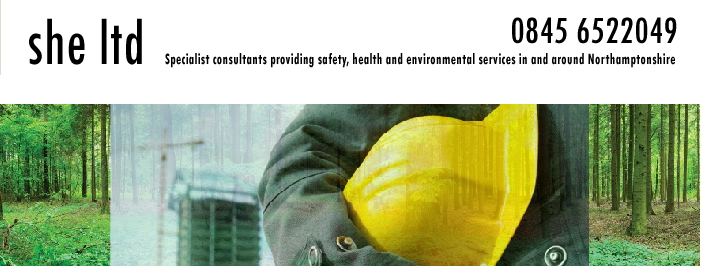Welcome to this month's safety health and Environmental newsletter. The idea of these newsletters is to raise awareness and to get you involved. This month’s topics are about Machinery and Manufacturing, and on Environmental Issues and how you can reduce your Carbon Footprint.
Work equipment and machinery
Work equipment covers an enormous range spanning process machinery, machine tools, office machines, lifting equipment, hand tools, ladders and pressure washers. Important points include: selecting the right equipment for the job, making sure equipment is safe to use and keeping it safe through regular maintenance, inspection and, if appropriate, thorough examination, training employees to use equipment safely and following manufacturers' or suppliers' instructions. Accidents involving work equipment happen all the time - many serious, some fatal.
The legislation for Work Equipment and Machinery is divided by three main regulations. The Provision and Use of Work Equipment Regulations 1998 (PUWER), The Supply of Machinery (Safety) Regulations 2008 (SMSR), and the Lifting Operations and Lifting Equipment regulations 1998 (LOLER). These are maintained by Responsibility for the enforcement of PUWER , SMSR, LOLER in workplaces is divided between the HSE and the Local Authorities. The HSE handles the legislation in areas of Manufacturing.
-The Provision and Use of Work Equipment Regulations 1998 (PUWER)
In general terms, PUWER requires that equipment provided for use at work is:
• suitable for the intended use;
• safe for use, maintained in a safe condition and, in certain circumstances, inspected to ensure this remains the case;
• used only by people who have received adequate information, instruction and training; and
• accompanied by suitable safety measures, e.g. protective devices, markings, warnings.
Full details of the requirements of PUWER are contained in the supporting Approved Code of Practice Safe use of work equipment. Provision and Use of Work Equipment Regulations 1998 L22 HSE Books 2008 ISBN 9780717662951[18] which has been updated to reflect the latest legislation. Requirements for power presses and woodworking machinery are dealt with in two separate Approved Codes of Practice.
-The Supply of Machinery (Safety) Regulations 2008 (SMSR)
These regulations impose duties upon those who place machinery and safety components onto the market, or put them into service (this includes second-hand machinery which is "new" to Europe). They set out the essential requirements which must be met before machinery or safety components may be placed on the market or put into service in the UK. They implement the latest version of the Machinery Directive 2006/42/EC and came into force on 29 December 2009, replacing the previous Supply of Machinery (Safety) Regulations 1992, as amended in 1994 and 2005.
There are basically four steps to dealing with the requirements:
• The responsible person should ensure that machinery and safety components satisfy the relevant Essential Health and Safety Requirements of the Supply of Machinery (Safety) Regulations and that, where appropriate, relevant conformity assessment procedures have been carried out;
• The responsible person must issue a Declaration of Conformity (DoC), or in the case of partly completed machinery a Declaration of Incorporation (DoI), which is issued with the product so that it is available to the user (or final machine assembler). This will contain various details such as the manufacturer's address, the machinery type and serial number, and the harmonised European, or other standards, used in design; and
• When the first two steps have been satisfactorily completed, the responsible person or person supplying, assembling or putting into service the final product should affix the CE marking if they are satisfied it is safe.
• When machinery is placed on the European market it must be accompanied by User Instructions in the language of the end user. In the case of partly completed machinery (PCM), instructions for the assembly of the PCM must be supplied.
The European Commission has published a Guide to the application of the Machinery Directive. It explains the scope and clarifies the application of the Directive to machinery and other equipment included within the definition of "machinery", particularly the interface with other product safety Directives. Background information on this Directive and the Supply of Machinery (Safety) Regulations is available from BIS (the Department for Innovation, Business & Skills).
-Lifting Operations and Lifting Equipment regulations 1998 LOLER
In general, LOLER requires that any lifting equipment used at work for lifting or lowering loads is:
• strong and stable enough for particular use and marked to indicate safe working loads;
• positioned and installed to minimise any risks;
• used safely, i.e. the work is planned, organised and performed by competent people; and
• subject to ongoing thorough examination and, where appropriate, inspection by competent people.
Full details of the requirements of LOLER are contained in the supporting Approved Code of Practice Safe use of lifting equipment. Lifting Operations and Lifting Equipment Regulations 1998. Approved Code of Practice and Guidance. L113 HSE Books 1998 ISBN 0 7176 1628 2.
Reducing your Carbon Footprint
Reducing your farm's carbon footprint may seem like yet another government requirement to make your life more difficult, but ongoing research has found making changes can bring significant financial benefits. Companies like Yara (The the world's leading manufacturer of fertilizers and crop nutrition knowledge), is helping the arable industry reduce its carbon footprint.
Through ongoing investment in new technology to ensure carbon efficient fertilizer production and transportation, plus research and promotion of best practice on arable farms, Yara is taking significant strides to address climate change.
For more on how they’re tackling the problem please follow the link below:
http://www.farming.co.uk/articles/view/4210
Monday, 27 June 2011
Subscribe to:
Post Comments (Atom)




No comments:
Post a Comment